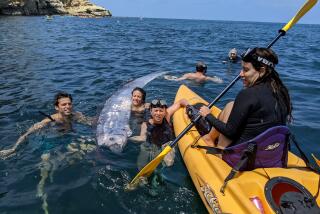They’re Lining Up at Museum to Get a Look at Dem Bones
- Share via
It is not the sexiest exhibit the San Diego Museum of History has ever presented, but the magnetism of a real dinosaur skeleton being chipped from its 70-million-year-old encasement draws kids like ants swarming to a picnic.
For that matter, adults also are pressing their noses against a glass partition at the museum to scrutinize the paleontologists hammering at blocks of mudstone as they painstakingly uncover the fossil remains of the first “armored” dinosaur found west of the Rockies.
The scientists, like the kids, are agog over the fossils--unearthed last month at an industrial park site in Carlsbad--which they believe are those of a nodosaurus or an ankylosaur.
Daily Discoveries
Almost every day brings some small new discovery for the tiny crew of paleontologists (scientists who study prehistoric life forms) and volunteers as they slowly free the bones from their concrete-like encasement.
“There’s something incredibly stimulating about working with something that’s never been seen by human eyes before,” said Margo Rausch, a senior volunteer who is allowed to assist in the process of “preparing” the fossils. “People are really fascinated. The kids stay here with their faces glued to the window.”
A group of fifth-graders from Lakeside on a field trip crowded around the window near Rausch’s microscope. Asked what they thought was happening, one girl answered: “They’re working on these bones. They’re picking them out of the rocks.”
Told the bones were 70 million years old, one girl turned to another and said: “Your parents weren’t even alive that long ago,” setting off giggles in another, who asked her classmates: “If you were a dinosaur, would you like somebody digging your bones up?”
As Rausch operates behind the partition, scratching a thin layer of mudstone off one of the armor plates, paleontologist Brad Riney wields a geologist’s pick on a slab of mudstone. The percussion of Riney’s pick echoes across the main floor exhibition space where the “working” exhibition has been set up.
“I wish this rock wasn’t so darn hard,” Riney said as the pick bounced off the dark gray stone. Riney had hacked away 100 pounds of the ancient, compressed mud the day before on a section he believes may contain the skull. But the mudstone layer beneath that was like concrete, he said, and will have to be removed by dipping it in an acid bath.
Riney, 33, has a nose for dinosaur bones, which have been found at only five sites in Southern California. Riney made four of those discoveries, including this one, which he uncovered while working
for Koll Construction Co. in Carlsbad. (The City of Carlsbad requires that developers retain paleontologists to survey any site for fossils prior to construction.)
Knack With Pick
Besides finding fossils, Riney has a knack with a pick, hammer and chisel for freeing them from sandstone or mudstone. However, Riney’s freewheeling technique, which occasionally results in broken fossils, makes other scientists hold their breath.
“Brad once did in an hour what would have taken (another worker) a week,” said Tom Demere, acting curator of the museum’s paleontology department. “But you couldn’t watch it,” Demere half-joked, for fear that Riney would destroy the fossils.
The donation of the dinosaur skeleton to the museum, while an embarrassment of riches, also poses a problem. Removing the fossilized bones from their stone prison will take at least eight months, Demere said. The unbudgeted costs could exceed $50,000.
“The museum can’t afford to pay for what’s going on down there,” Demere said from his office on the third floor. Riney and another scientist continue to attack a couple of thousand pounds of stone, meanwhile, in hopes that funding will be found.
The museum has dubbed the fossils the Koll dinosaur, because it was found at the Koll construction site. Acting museum director Fred Schram said that the museum hopes to find donors to help pay for cleaning up the fossils.
More to Read
Sign up for Essential California
The most important California stories and recommendations in your inbox every morning.
You may occasionally receive promotional content from the Los Angeles Times.













